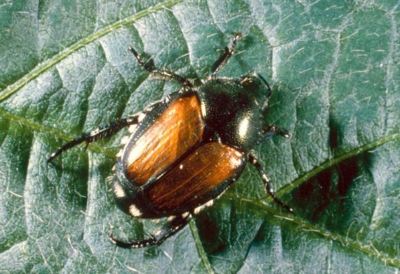Japanese Beetles Damage
A serious problem in the eastern United States and becoming more prominent on Colorado’s Front Range, Japanese beetles can damage turfgrass and leaves, buds and flowers of many of the plants home gardeners work diligently to cultivate.
Adult beetles enjoy munching on the soft tissue between leaf veins in a pattern often referred to as skeletonizing. But they also like taking a bite here or there on buds and flower petals, leaving ragged evidence of their presence. Roses, not an easy plant to cultivate, are a particular favorite of the beetles and the destruction can be heartbreaking.
Japanese Beetle Control
One of the easiest ways to control Japanese beetles is – literally – always at hand. The insects aren’t shy (in fact, they frequently land on people and pets), so it’s relatively easy to pick them off plants. Potted plants can be gently shaken over a collection container that contains soapy water every morning. Definitely don’t step on or otherwise squash beetles. The pheromones that are released will just attract more of the pests.
Chemical treatment and sprays that contain Neem oil are often required when extreme damage indicates a more serious problem. Japanese beetles like to gather and existing damage on a plant is evidence of a good gathering spot and attracts even more of the insects to your garden. If feeding continues after hand-picking efforts, the next step is probably chemical treatment.
Some chemical treatment can be applied directly to plants, but other treatments – especially lawn treatment – requires precisely timed application to the soil. Many homeowners rely on professionals because application is aided by dry soil during the hottest part of summer. The delicate balance between proper irrigation and drying out beetle eggs is often a frustrating experience for non-professionals.
If Japanese beetles are a concern, contact SprayTech, Colorado commercial and residential insect treatment specialists, at 720-248-0000 to discuss treatment options.


